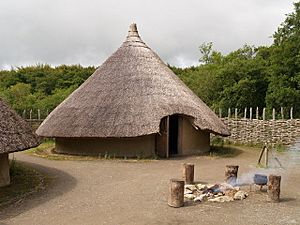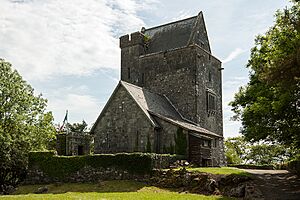Craggaunowen facts for kids
| Creagán Eoghain | |

Conical hut on the reconstructed crannóg
|
|
| Lua error in Module:Location_map at line 420: attempt to index field 'wikibase' (a nil value). | |
| Established | 1965 |
|---|---|
| Location | Craggaunowen, Kilmurry, County Clare, Ireland |
| Type | open-air museum |
| Founder | John Hunt |
| Public transit access | none |
| Nearest car park | On-site |
Craggaunowen is an exciting archaeological open-air museum located in eastern County Clare, Ireland. It's famous for its 16th-century castle, which is a big part of what you can see there.
The museum is about 10 kilometers east of Quin village. Its name, Craggaunowen, comes from the Irish words Creagán Eoghain, meaning "Owen's little rocky hill." Shannon Heritage operates this interesting historical site.
Contents
Explore the Living Past at Craggaunowen
The open-air museum at Craggaunowen is often called a "Living Past Experience." It was started by John Hunt right around the old castle. Here, you can see amazing reconstructions of ancient Irish buildings and structures.
- You can explore a dolmen, which is an ancient stone tomb.
- There's a reconstructed crannóg, a type of island home built in lakes.
- See a replica of the currach boat. This boat was used by Tim Severin to recreate "The Voyage of St. Brendan the Abbot."
- Discover a Ringfort, a circular fortified settlement.
- Learn about Fulachta Fia, which were Bronze Age sites used for cooking and other activities.
- Check out a Standing Stone, also known as an Ogham Stone, with ancient Irish writing.
Craggaunowen Castle: A Journey Through Time
Building and Early History of the Castle
Craggaunowen Castle was built around the year 1550. It was constructed by John MacSioda MacNamara. His family was well-known for building castles, like Knappogue Castle in 1467.
However, the castle became a ruin in the 17th century. Around 1653, during the Cromwellian period, its roof and staircase were removed. This made it impossible to live in and difficult to defend.
The Castle in the 1800s
The tower house stayed a ruin for many years. In 1821, "Honest" Tom Steele inherited the castle and the nearby Cullane House estate. Steele was a friend and supporter of Daniel O'Connell, who was known as "The Liberator."
Steele decided to rebuild the castle in the 1820s. He used it as a summer house, a place for relaxation. You can still see his initials on one of the corner stones outside the castle. After Steele passed away in 1848, his lands were divided. The castle eventually went to his niece, Maria Studdert.
Later, the castle and its grounds were bought by the Irish Land Commission. Much of the land was used for growing trees, and the castle was allowed to fall into disrepair again. By the 1840s, it was once more a ruin. In the mid-19th century, a Reverend William Ashworth owned the castle and 96 acres of land.
Restoration of Craggaunowen Castle in the 20th Century
In 1906, a large house at the site was owned by Count James Considine.
Craggaunowen Castle was bought and beautifully restored by John Hunt in the 1960s. Hunt was an antiquarian, meaning he studied and collected ancient objects. He added an extension to the ground floor of the castle. For a while, this extension held part of his amazing collection of old artifacts.
Later, his collection was moved to the University of Limerick. As of 2025, these valuable antiquities are kept at the Hunt Museum in Limerick city.


